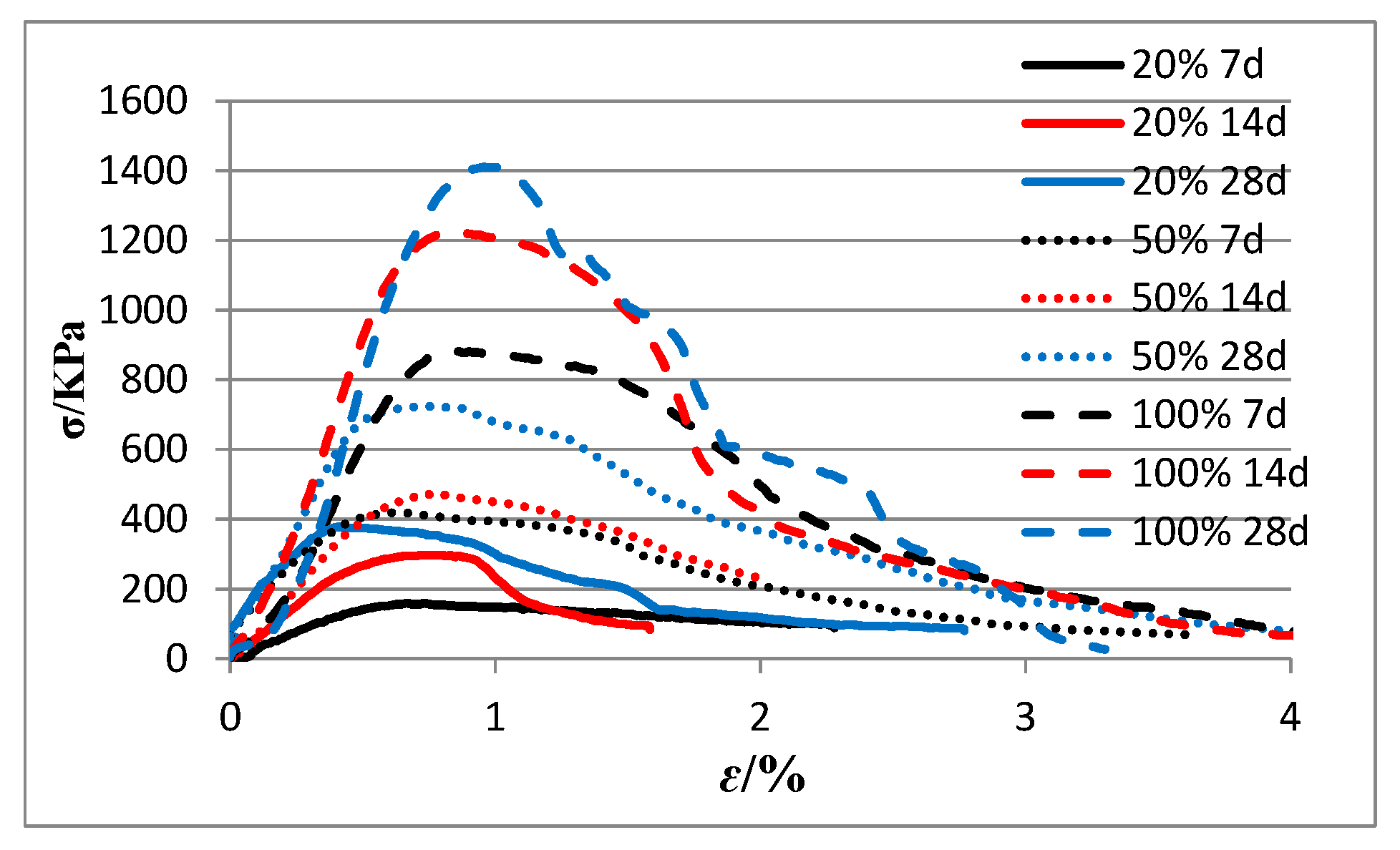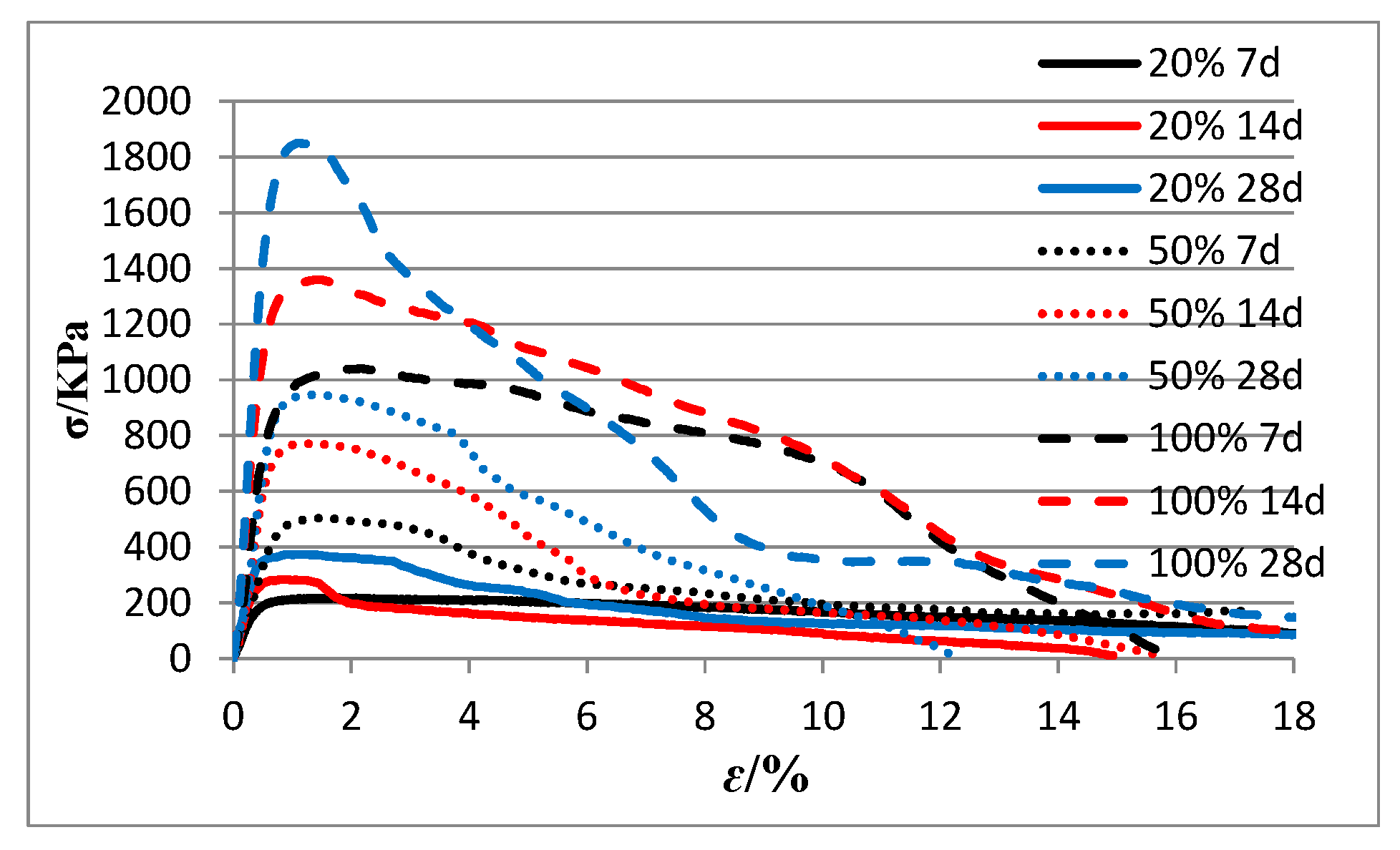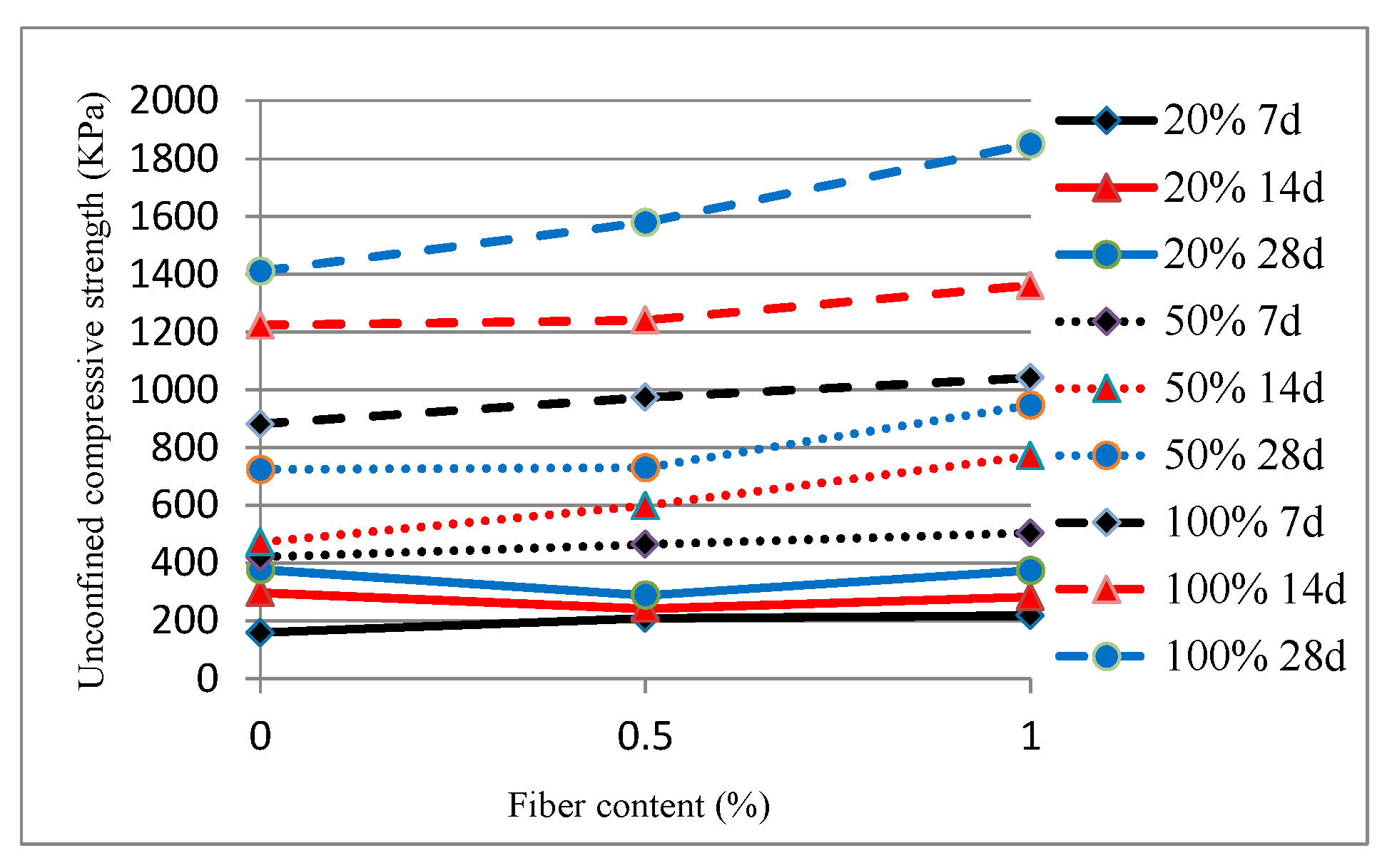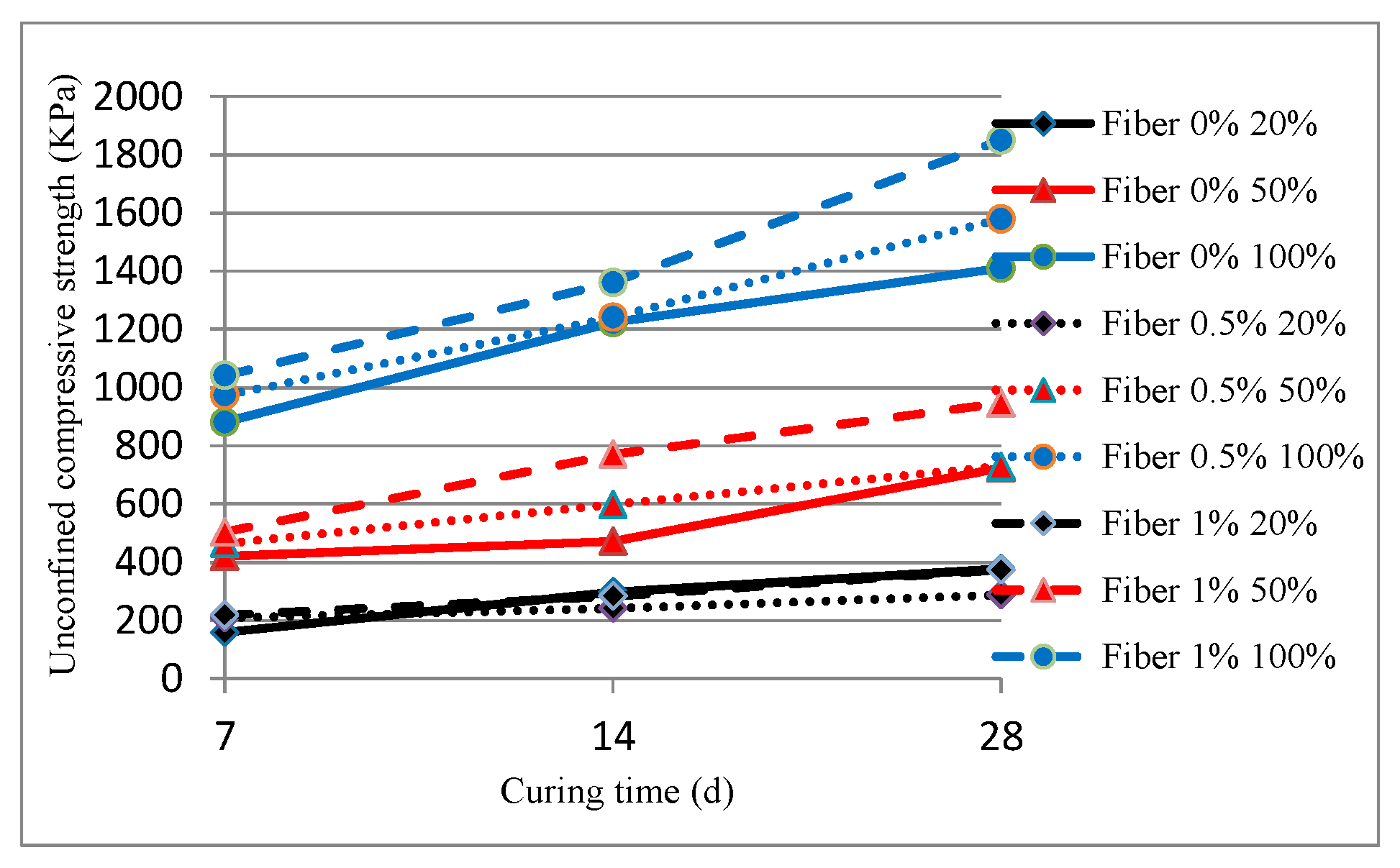Experimental Study on Unconfined Compression Strength of Polypropylene Fiber Reinforced Composite Cemented Clay
Abstract
1. Introduction
2. Materials and Experimental Methodology
2.1. Materials
2.2. Experiment Scheme
2.3. Sample Preparation and Testing
3. Results and Discussion
3.1. Stress-Strain Behavior
3.2. Effect of Fiber Content on Unconfined Compressive Strength
3.3. Effect of Fly Ash Cement Content on Unconfined Compressive Strength
3.4. Effect of Curing Time on Unconfined Compressive Strength
3.5. Failure Modes
4. Conclusions
Author Contributions
Funding
Acknowledgments
Conflicts of Interest
References
- Liu, Y.; Jiang, Y.; Xiao, H.; Lee, F.H. Determination of representative strength of deep cement-mixed clay from core strength data. Géotechnique 2017, 67, 350–364. [Google Scholar] [CrossRef]
- Consoli, N.C.; Da Fonseca, A.V.; Silva, S.; Cruz, R.; Fonini, A. Parameters controlling stiffness and strength of artificially cemented soils. Géotechnique 2012, 62, 177–183. [Google Scholar] [CrossRef]
- Kamruzzaman, A.H.; Chew, S.H.; Lee, F.H. Structuration and Destructuration Behavior of Cement-Treated Singapore Marine Clay. J. Geotech. Geoenviron. Eng. 2009, 135, 573–589. [Google Scholar] [CrossRef]
- Lee, F.H.; Lee, Y.; Chew, S.-H.; Yong, K.-Y. Strength and Modulus of Marine Clay-Cement Mixes. J. Geotech. Geoenviron. Eng. 2005, 131, 178–186. [Google Scholar] [CrossRef]
- Liu, Y.; Chen, E.J.; Quek, S.-T.; Yi, J.-T.; Lee, F.H. Effect of spatial variation of strength and modulus on the lateral compression response of cement-admixed clay slab. Géotechnique 2015, 65, 851–865. [Google Scholar] [CrossRef]
- Xiao, H. Evaluating the Stiffness of Chemically Stabilized Marine Clay. Mar. Georesources Geotechnol. 2016, 35, 698–709. [Google Scholar] [CrossRef]
- Xiao, H.; Lee, F.H.; Liu, Y. Bounding Surface Cam-Clay Model with Cohesion for Cement-Admixed Clay. Int. J. Géoméch. 2017, 17, 04016026. [Google Scholar] [CrossRef]
- Liu, Y.; He, L.Q.; Jiang, Y.J.; Sun, M.M.; Chen, E.J.; Lee, F.-H. Effect of in situ water content variation on the spatial variation of strength of deep cement-mixed clay. Géotechnique 2019, 69, 391–405. [Google Scholar] [CrossRef]
- Xiao, H.W.; Wang, W.; Goh, S.H. Effectiveness study for fly ash cement improved marine clay. Constr. Build. Mater. 2017, 157, 1053–1064. [Google Scholar] [CrossRef]
- Show, K.-Y.; Tay, J.-H.; Goh, A. Reuse of Incinerator Fly Ash in Soft Soil Stabilization. J. Mater. Civ. Eng. 2003, 15, 335–343. [Google Scholar] [CrossRef]
- Zhou, N.; Ouyang, S.; Cheng, Q.; Ju, F. Experimental Study on Mechanical Behavior of a New Backfilling Material: Cement-Treated Marine Clay. Adv. Mater. Sci. Eng. 2019, 2019, 1–8. [Google Scholar] [CrossRef]
- Zentar, R.; Wang, D.; Abriak, N.-E.; Benzerzour, M.; Chen, W. Utilization of siliceous–aluminous fly ash and cement for solidification of marine sediments. Constr. Build. Mater. 2012, 35, 856–863. [Google Scholar] [CrossRef]
- Xiao, H.; Shen, W.; Lee, F.H. Engineering Properties of Marine Clay Admixed with Portland Cement and Blended Cement with Siliceous Fly Ash. J. Mater. Civ. Eng. 2017, 29, 04017177. [Google Scholar] [CrossRef]
- Cheng, Q.; Xiao, H.; Liu, Y.; Wang, W.; Jia, L. Primary yielding locus of cement-stabilized marine clay and its applications. Mar. Georesources Geotechnol. 2018, 37, 488–505. [Google Scholar] [CrossRef]
- Anggraini, V.; Huat, B.B.K.; Asadi, A.; Nahazanan, H. Effect of Coir Fibers on the Tensile and Flexural Strength of Soft Marine Clay. J. Nat. Fibers 2014, 12, 185–200. [Google Scholar] [CrossRef]
- Tang, C.-S.; Shi, B.; Gao, W.; Chen, F.; Cai, Y. Strength and mechanical behavior of short polypropylene fiber reinforced and cement stabilized clayey soil. Geotext. Geomembr. 2007, 25, 194–202. [Google Scholar] [CrossRef]
- Kaniraj, S.R.; Havanagi, V.G. Behavior of Cement-Stabilized Fiber-Reinforced Fly Ash-Soil Mixtures. J. Geotech. Geoenviron. Eng. ASCE. 2001, 127, 574–584. [Google Scholar] [CrossRef]
- Correia, A.A.S.; Paulo, J.V.O.; Custódio, D.G. Effect of polypropylene fibers on the compressive and tensile strength of a soft soil, artificially stabilised with binders. Geotext. Geomemb. 2015, 43, 97–106. [Google Scholar] [CrossRef]
- Xiao, H.; Liu, Y. A prediction model for the tensile strength of cement-admixed clay with randomly orientated fibers. Eur. J. Environ. Civ. Eng. 2016, 22, 1131–1145. [Google Scholar] [CrossRef]
- Ding, M.; Zhang, F.; Ling, X.; Lin, B. Effects of freeze-thaw cycles on mechanical properties of polypropylene Fiber and cement stabilized clay. Cold Reg. Sci. Technol. 2018, 154, 155–165. [Google Scholar] [CrossRef]
- Li, Q.; Chen, J.; Hu, H. The tensile and swelling behavior of cement-stabilized marine clay reinforced with short waste fibers. Mar. Georesources Geotechnol. 2019, 37, 1236–1246. [Google Scholar] [CrossRef]
- Chin, K.G.; Lee, F.H.; Dasari, G.R. Effects of curing stress on mechanical properties of cement-treated soft marine clay. In Proceedings of the International Symposium on Engineering Practice and Performance of Soft Deposits, Toyonaka, Japan, 2–4 June 2004; pp. 217–222. [Google Scholar]
- Cheng, Q.; Yao, K.; Liu, Y. Stress-Dependent Behavior of Marine Clay Admixed with Fly-Ash-Blended Cement. Int. J. Pavement. Res. Technol. 2018, 11, 611–616. [Google Scholar] [CrossRef]
- Geotechnical Investigation and Testing—Laboratory Testing of Soil— Part 7; ISO/TS 17892; International Organization for Standardization: Geneva, Switzerland, 2004.







| Water Content (%) | Specific Gravity, Gs (Mg/m3) | Liquid Limit (%) | Plastic Limit (%) | Plasticity Index (%) |
|---|---|---|---|---|
| 88 | 2.7 | 73 | 32 | 41 |
| Initial Setting Time (h) | Final Setting Time (h) | Stability | Loss on Ignition (%) | Compressive Strength (MPa) | Flexural Strength (MPa) | ||
|---|---|---|---|---|---|---|---|
| 3 d | 28 d | 3 d | 28 d | ||||
| 2:30 | 4:00 | Qualified | 1.3 | 24 | 43.0 | 4.8 | 7.2 |
| Type | Density (g/cm3) | Length (mm) | Tensile Strength (MPa) | Acid and Alkali Resistance | Dispersion |
|---|---|---|---|---|---|
| Monofilament | 0.91 | 6 | >360 | High performance | Good |
| Polypropylene Fiber Content (%) | Fly Ash Cement Content (%) | Curing Time (d) | Water Content (%) |
|---|---|---|---|
| 0 | 20, 50, 100 | 7 | 100 |
| 20, 50, 100 | 14 | ||
| 20, 50, 100 | 28 | ||
| 0.5 | 20, 50, 100 | 7 | |
| 20, 50, 100 | 14 | ||
| 20, 50, 100 | 28 | ||
| 1 | 20, 50, 100 | 7 | |
| 20, 50, 100 | 14 | ||
| 20, 50, 100 | 28 |
| Fly Ash Cement Content (%) | Curing Time (d) | Polypropylene Fiber Content (%) | ||
|---|---|---|---|---|
| 0 | 0.5 | 1 | ||
| 20 | 7 | 0.668 | 1.474 | 1.604 |
| 14 | 0.716 | 1.566 | 0.797 | |
| 28 | 0.4 | 0.778 | 0.908 | |
| 50 | 7 | 0.63 | 1.597 | 1.427 |
| 14 | 0.744 | 1.468 | 1.24 | |
| 28 | 0.727 | 1.257 | 1.397 | |
| 100 | 7 | 0.865 | 1.855 | 2.17 |
| 14 | 0.807 | 1.579 | 1.466 | |
| 28 | 0.952 | 1.483 | 1.083 | |
© 2020 by the authors. Licensee MDPI, Basel, Switzerland. This article is an open access article distributed under the terms and conditions of the Creative Commons Attribution (CC BY) license (http://creativecommons.org/licenses/by/4.0/).
Share and Cite
Cheng, Q.; Zhang, J.; Zhou, N.; Guo, Y.; Pan, S. Experimental Study on Unconfined Compression Strength of Polypropylene Fiber Reinforced Composite Cemented Clay. Crystals 2020, 10, 247. https://doi.org/10.3390/cryst10040247
Cheng Q, Zhang J, Zhou N, Guo Y, Pan S. Experimental Study on Unconfined Compression Strength of Polypropylene Fiber Reinforced Composite Cemented Clay. Crystals. 2020; 10(4):247. https://doi.org/10.3390/cryst10040247
Chicago/Turabian StyleCheng, Qiangqiang, Jixiong Zhang, Nan Zhou, Yu Guo, and Shining Pan. 2020. "Experimental Study on Unconfined Compression Strength of Polypropylene Fiber Reinforced Composite Cemented Clay" Crystals 10, no. 4: 247. https://doi.org/10.3390/cryst10040247
APA StyleCheng, Q., Zhang, J., Zhou, N., Guo, Y., & Pan, S. (2020). Experimental Study on Unconfined Compression Strength of Polypropylene Fiber Reinforced Composite Cemented Clay. Crystals, 10(4), 247. https://doi.org/10.3390/cryst10040247






